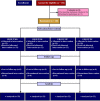Comparative evaluation of intranasal midazolam-ketamine, dexmedetomidine-ketamine, midazolam-fentanyl, and dexmedetomidine-fentanyl combinations for procedural sedation and analgesia in pediatric dental patients: a randomized controlled trial
- PMID: 37034838
- PMCID: PMC10079769
- DOI: 10.17245/jdapm.2023.23.2.69
Comparative evaluation of intranasal midazolam-ketamine, dexmedetomidine-ketamine, midazolam-fentanyl, and dexmedetomidine-fentanyl combinations for procedural sedation and analgesia in pediatric dental patients: a randomized controlled trial
Abstract
Background: In order to assess the effectiveness of various analgesio-sedative combinations for pain relief and sedation in pediatric dental patients, a thorough evaluation of clinical studies and patient outcomes is necessary.
Methods: A total of 128 healthy, uncooperative pediatric dental patients were randomly allocated to receive one of the four combinations of drugs via the intranasal (IN) route: Group I received midazolam-ketamine (MK), Group II received dexmedetomidine-ketamine (DK), Group III received midazolam-fentanyl (MF), and Group IV received dexmedetomidine-fentanyl (DF) in a parallel-arm study design. The efficacy and safety of the combinations were evaluated using different parameters.
Results: The onset of sedation was significantly faster in the DF group than in the DK, MF, and MK groups (P < 0.001). The depth of sedation was significantly higher in the DK and DF groups than in the MK and MF groups (P < 0.01). DK and DF produced significant intra- and postoperative analgesia when compared with combinations of MK and MF. No significant adverse events were observed for any of the combinations.
Conclusions: The DK and DF groups showed potential as analgesio-sedatives in view of their anxiolytic and analgesic effects.
Keywords: Analgesio-sedation; Dental anxiety; Dexmedetomidine; Fentanyl; Ketamine; Midazolam.
Copyright © 2023 Journal of Dental Anesthesia and Pain Medicine.
Conflict of interest statement
DECLARATION OF INTERESTS: The authors have no conflicts of interest to declare.
Figures


Similar articles
-
Dexmedetomidine-ketamine versus Dexmedetomidine-midazolam-fentanyl for monitored anesthesia care during chemoport insertion: a Prospective Randomized Study.BMC Anesthesiol. 2016 Aug 2;16(1):49. doi: 10.1186/s12871-016-0211-4. BMC Anesthesiol. 2016. PMID: 27484227 Free PMC article. Clinical Trial.
-
A Comparison of Oral Midazolam-ketamine, Dexmedetomidine-fentanyl, and Dexmedetomidine-ketamine Combinations as Sedative Agents in Pediatric Dentistry: A Triple-Blinded Randomized Controlled Trial.Contemp Clin Dent. 2018 Sep;9(Suppl 2):S197-S203. doi: 10.4103/ccd.ccd_818_17. Contemp Clin Dent. 2018. PMID: 30294144 Free PMC article.
-
A comparative evaluation of intranasal dexmedetomidine, midazolam and ketamine for their sedative and analgesic properties: a triple blind randomized study.J Clin Pediatr Dent. 2014 Spring;38(3):255-61. doi: 10.17796/jcpd.38.3.l828585807482966. J Clin Pediatr Dent. 2014. PMID: 25095322 Clinical Trial.
-
Comparative effectiveness and safety of dexmedetomidine and midazolam in pediatric dental sedation: a systematic review and meta-analysis.J Dent Anesth Pain Med. 2025 Jun;25(3):147-159. doi: 10.17245/jdapm.2025.25.3.147. Epub 2025 May 30. J Dent Anesth Pain Med. 2025. PMID: 40521425 Free PMC article. Review.
-
Efficacy of intranasal sedation for pediatric dental procedures: a systematic review and meta-analysis.J Dent Anesth Pain Med. 2025 Feb;25(1):1-13. doi: 10.17245/jdapm.2025.25.1.1. Epub 2025 Jan 22. J Dent Anesth Pain Med. 2025. PMID: 39944848 Free PMC article. Review.
Cited by
-
The effect of dexmedetomidine-ketamine combination versus dexmedetomidine on behavior of uncooperative pediatric dental patients: a randomized controlled clinical trial.J Appl Oral Sci. 2024 Sep 20;32:e20240057. doi: 10.1590/1678-7757-2024-0057. eCollection 2024. J Appl Oral Sci. 2024. PMID: 39319902 Free PMC article. Clinical Trial.
-
Trial Sequential Analysis and Meta-analysis of Intranasal Ketamine Versus Intranasal Opioids for Analgesia in Paediatric Patients.Ann Neurosci. 2025 Mar 1:09727531251317292. doi: 10.1177/09727531251317292. Online ahead of print. Ann Neurosci. 2025. PMID: 40041602 Free PMC article. Review.
-
Recovery Time, Patient Satisfaction, and Safety of Intranasal Sedatives in Pediatric Dentistry: A Systematic Review and Meta-Analysis.J Clin Med. 2025 Jun 7;14(12):4038. doi: 10.3390/jcm14124038. J Clin Med. 2025. PMID: 40565785 Free PMC article. Review.
-
Intranasal Therapy in Palliative Care.Pharmaceutics. 2024 Apr 9;16(4):519. doi: 10.3390/pharmaceutics16040519. Pharmaceutics. 2024. PMID: 38675179 Free PMC article. Review.
-
Drugs for Procedural Sedation and Analgesia in Children: A Systematic Review and Meta-analysis.Drugs R D. 2025 Aug 13. doi: 10.1007/s40268-025-00522-9. Online ahead of print. Drugs R D. 2025. PMID: 40804602
References
-
- Hosey MT. Anxious children: coping in dental practice. Dent Update. 1995;22:210–215. - PubMed
-
- Milgrom P, Fiset L, Melnick S, Weinstein P. The prevalence and practice management consequences of dental fear in a major US city. J Am Dent Assoc. 1988;116:641–647. - PubMed
-
- De Jongh A, Adair P, Meijerink-Anderson M. Clinical management of dental anxiety: what works for whom? Int Dent J. 2005;55:73–80. - PubMed
-
- Folayan MO, Faponle A, Lamikanra A. Seminars on controversial issues. A review of the pharmacological approach to the management of dental anxiety in children. Int J Paediatr Dent. 2002;12:347–354. - PubMed
-
- Krauss B, Green SM. Procedural sedation and analgesia in children. Lancet. 2006;367:766–780. - PubMed
LinkOut - more resources
Full Text Sources
Miscellaneous

